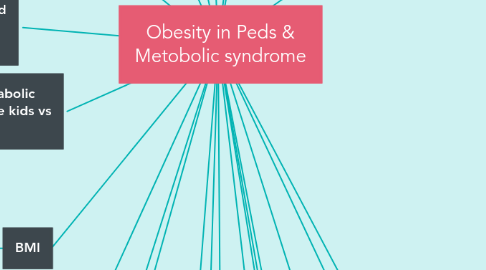
1. childhood obesity more common in certain populations:
1.1. hispanics>non-hispanic blacks>non-hispanic whites>non-hispanic asians
2. Why worry?
2.1. Peds obesity is of epidemic proportions
2.2. peds obesity is the most common chronic dx of childhood
2.3. the epidemic is worldwide
3. Obesity & Socioeconomic Status
3.1. obesity decreases w/ increasing education of the head of household among children aged 2-19 years
3.2. middle income>lowest income>highest income
4. only 21% 6-9y/o eat 5or> fruits/veggies a day
5. consumption of sugar sweetened drinks increased 500% in past 50years
6. little evidence that metabolic rate is different in obese kids vs not obese kids
7. BMI
7.1. underweight=<5%ile
7.2. healthy weight=5-85%ile
7.3. overweight=85-95%ile
7.4. obese=@ or above 95%ile
7.5. BMI IS A SCREEN NOT A DIAGNOSTIC TOOL.
7.5.1. BMI interpreted diff. for children and teens even though calculated weight / height squared
8. 60% of overweight kids have 1 or more CVD risk factors
8.1. OBTAIN FASTING LIPID PROFILE and BP on all overweight children
9. ortho conditions
9.1. Blount disease
9.2. Slipped Capital Femoral Epiphysis
10. Psychological & Economic consequences of Ped/Adolescent obesity
10.1. Discrimination,rejection,&low self esteem,particularly females
10.2. Less participation in PE & sports activites
10.3. Difficult to quantitate
10.4. stigmatization
10.5. low self esteem
10.6. depression
10.7. discrimination
11. TREATMENT
11.1. prevention easier than cure
11.2. lifelong weight control
11.3. decrease energy intake
11.4. increase energy expenditure
11.5. must maintain normal growth
11.6. 55%carbs; 30%fat; 15%protein
11.7. physical activity essential for weight loss(physical activity decreases 50% during adolescent-girls>boys)
11.8. FOOD DIARIES
11.9. surgeries
11.9.1. gastric bypass/gastric plication/gastric banding--- not routine for children
12. Management
12.1. small reduction in cals allows gradual decline in BMI
12.2. weight loss of 0.5-1 kg/week is the goal
12.3. rapid weight loss can lead to electrolyte disturbance
12.4. special diets like protein rich diet not recommended
12.5. GET UP & MOVE
13. association b/w catch-up growth or rapid growth in infancy or early childhood & subsequent obesity
13.1. suggests that mechanisms that signal & regulate catch up growth in postnatal period may play a role in development of obesity????
14. Increasing age=increasing obesity prevalence
15. Etiology of obesity
15.1. genetic/heritability
15.1.1. survival advantage-conserve energy as fat thru human evolution
15.1.2. humans enriched for genes that promote energy intake & storage & minimize expenditure
15.1.3. enhance female fertility & ability to breastfeed offspring
15.2. Molecular
15.2.1. Leptin=regulate fat storage & how many calories one eats & burns
15.2.1.1. "satiety hormone"/"starvation hormone"
15.2.1.2. hormone produced by body's fat cells-primary target is hypothalamus. supposed to tell brain when you have enough fat stored=don't need to eat & can burn cals @normal rate
15.2.1.3. other functions=fertility,immunity,&brain function
15.2.1.4. leptin resistance can cause hunger & reduced the number of cals burned
15.3. syndromes
15.3.1. spina bifida
15.3.2. Down syndrome
15.3.3. Bardet-Biedl
15.3.4. Prader Willi
15.4. environmental
15.5. MULTI-FACTORIAL CONDITION
16. nearly 40%kids'diets come from added sugars & unhealthy fats
17. shifts in dietary patterns
17.1. prices higher in healthy foods vs less healthful
17.2. increased portion size
17.3. increased consumption of processed foods/higher in sodium
17.4. increased schools vending & a la carte foods
18. energy intake>energy expenditure
18.1. eating more away from home,more fast food & snacks & drinking more sodas.
18.2. 100cals/day above needs=10lb weight gain/year
18.3. increased sedentary activity
18.3.1. excessive TV watching
18.3.1.1. encourages overeating while viewing
18.3.1.2. 70% KIDS 8-18 & 30% KIDS < 3 Y/O HAVE TVS IN THEIR ROOMS!!!
19. GOAL for obese kids
19.1. reduce rate of weight gain while allowing NORMAL growth and development
20. ACANTHOSIS NIGRICANS
21. acute complications that require immediate Med. attn:
21.1. Sleep apnea
21.2. Obesity hypo-ventilation syndrome
22. Obesity Metabolic syndrome:
22.1. clustering of CV risk factors related to insulin resistance
22.2. NOT well defined in Peds
22.2.1. insulin resistance
22.2.2. dyslipidemia
22.2.3. HTN
22.2.4. obesity
22.3. Steatohepatitis
22.3.1. fatty infiltration of the liver
22.3.2. abnormal insulin metabolism
22.3.3. 10% obese teens increased LFTs
22.3.4. can progress to fibrosis & cirrhosis
22.4. Gall bladder disease
22.4.1. increased cholesterol excretion
22.4.2. ~30% of gallstones in children
22.5. oligomenorrhea/amenorrhea, acanthosis nigricans, insulin resistance, obesity, hirsutism, acne, hyperandrogenism
23. Pharmacotherapy
23.1. anti obesity pills not approved for peds
23.2. drug options
23.2.1. appetite suppressants
23.2.2. serotonin agonists
23.2.3. inhibitors of fat absorption
23.2.4. antihyperglycemic agents
